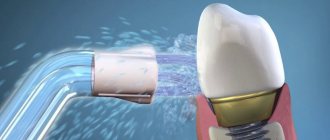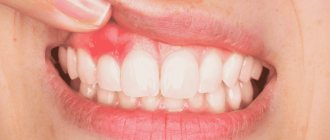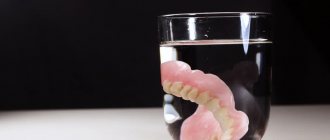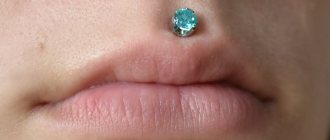- Features of light seals
- When to eat mono after filling?
- What products should you be careful with?
- What complications can there be?
- If the seal falls out or is damaged
In modern dentistry, when reconstructing teeth with composite materials, preference is given to light fillings, which have many advantages over the classic filling composition. A light filling is more convenient to install, less toxic, resistant to heavy loads, looks more natural, and can even match the color of tooth enamel. However, in order to maintain the result achieved by the specialist and not provoke separation of the composite, the recommendations of the attending physician should be followed. One of the main questions that patients ask is when can they eat after a light tooth filling and are there any dietary restrictions in the future.
How much can you not eat after having a filling installed?
All patients are interested in whether they can eat after having a filling installed.
You can eat food, but not immediately after the event, but after some time. Experts use various compositions, and each of them has its own hardening time. But first, you need to consider what you can’t eat after installing a filling in order to avoid its premature destruction.
The list of prohibited products includes all solid products, including chips and crackers, viscous - toffee and other products of similar consistency, coloring - coffee and tea, tomatoes, beets and the like. The consumption of hard and viscous products contributes to the destruction of the filling, and the use of coloring products causes a change in the color of the filling material.
Temporary restrictions
The first question that patients ask the doctor after treatment is: how long can you not eat? It all depends on the technology used, and some of them allow you to eat food almost immediately.
But there is one caveat. Even if the top layer has already hardened, the inner layer is subject to deformation. Therefore, there is no need to rush. There are the following general recommendations on time limits (according to the type of material):
- amalgam – 3 hours;
- plastic – from 3 to 5 hours;
- cement - from 2 to 3 hours;
- photocurable composites – can be eaten immediately;
- chemically cured composites – 1 hour;
- temporary fillings except photopolymer ones – from 2 to 3 hours;
- photopolymer temporary fillings – no restrictions.
How to maintain your treatment guarantee
As a rule, therapeutic treatment, that is, dental filling, is guaranteed from 6 months to 2 years - depending on the volume of work and the complexity of the situation. To maintain the guarantee, the patient must strictly follow all recommendations: do not overload the tooth, do not use it for other purposes (for example, open beer bottles), and also regularly see the doctor in accordance with the individual schedule of medical examinations. Unfortunately, many patients forget about this, and it is the last point that is the key to maintaining the guarantee for treatment.
You need to visit a doctor 1-2 times a year. During a preventive examination, the dentist will be able to make sure that the filling is in good condition and that caries does not develop again underneath it.
Is it possible to drink after having a filling installed?
At the appointment, patients always ask whether they can drink tea or other drinks after treatment. In this case, the same recommendations apply as for eating - it all depends on the technology. But there are also additional restrictions. Drinking drinks is not recommended until the anesthesia effect has completely subsided.
This is due to the possibility of injury to the mucous membrane by too hot a liquid, because sensitivity is reduced. It is very difficult to say exactly how long you can drink. In this case, everything depends on the effectiveness of the painkiller, its duration of action, dosage and individual reaction of the body.
Is it possible to drink: what do doctors say?
If you prefer a restoration method such as a light filling, then now you know exactly how long you can eat after its installation. What about drinking liquids in the form of water, coffee, tea, etc.? Experts recommend not drinking for at least 30-60 minutes after treatment with photopolymer composite materials. This is again due to the reduced sensitivity of tissues and the likelihood of injury to them, for example, with hot tea. And not because liquids will lead to deterioration of the properties of the material and disruption of its adhesion.
As for the intake of alcoholic beverages, it is better to avoid them on the first day after treatment, especially if the procedures were carried out under anesthesia. Remember that alcohol and anesthesia are not compatible; they can cause a negative reaction in the body, increase blood pressure, increase swelling, provoke bleeding (if a complex intervention or surgery was performed) and increase tissue healing time.
Notice
: Undefined variable: post_id in
/home/c/ch75405/public_html/wp-content/themes/UltraSmile/single-item.php
on line
45 Notice
: Undefined variable: full in
/home/c/ch75405/public_html/wp-content /themes/UltraSmile/single-item.php
on line
46
Rate this article:
( 1 ratings, average: 5.00 out of 5)
dental fillings
[1] Bodrova A.A. Achievements of scientific and technological progress in the development of dental filling materials. // Bulletin of medical Internet conferences. – 2014.
Recommendations
Immediately after installation, you must refrain from drinking and eating for the time recommended by the dentist until the final effect of the pain medication. After this period, you should not eat foods that are too hot or too cold, as they may affect the strength properties of the material.
The load should be moderate. It is advisable to try not to chew on this side of the jaw during the day, since the filling may become loose if it does not harden sufficiently.
In addition to traditional questions about food and drink, dental visitors are also interested in additional questions.
Is it possible to drink alcohol
In fact, alcohol does not have any special effect, which means that theoretically it can be consumed. But the point here is completely different. In most cases, filling is performed under anesthesia, and it and alcohol are incompatible. Therefore, experts recommend abstaining from alcohol for at least a day.
The same can be answered to the question “can I drink beer?” After 24 hours, yes, you can. Beer does not contain coloring enzymes and fillings do not change color under its influence.
Is it possible to smoke after installation?
After the filling procedure, you can smoke approximately 2-3 hours later.
. Tobacco smoke does not affect the color of the filling, unless it concerns plastic-based compounds. They are rarely used due to their fragility, but when using such a composition, smoking immediately after the procedure will cause its darkening. Ideally, dentists recommend giving up cigarettes for at least a day, if possible.
What complications can there be?
After the light reflection filling is installed, how long before you can eat? Our clinic specialists advise patients to abstain from food for 2 hours and from drinking for 1 hour. Such recommendations are not mandatory, but they can reduce the risk of complications after filling.
If the recommended time interval is not observed, complications may arise:
- rapid darkening of tooth enamel;
- staining of enamel (under the influence of dyes);
- It's a dull pain;
- swelling of the gums;
- crown destruction;
- filling falling out.
Also, in the first days after filling, patients should avoid eating any foods with increased hardness. In particular, it is not advisable to chew seeds, nuts or objects (for example, a pencil or pen).
What not to do after installation
The main thing that should not be done after installation is to subject the tooth to increased loads.
. Therefore, gnawing any foods (nuts, seeds, candies, etc.) is highly discouraged. Avoid the use of chewing gum, toffees and other similar confectionery products that tend to stick to teeth.
The consumption of hot and cold foods is limited; this can cause the filling material to break prematurely.
There should be no traumatic impact on the tooth, therefore, if discomfort is felt, you should consult a doctor and not take any action yourself.
Is it possible to brush your teeth
A specialist will definitely advise you on how to brush your teeth after installing a filling. It is advisable to do this only the next day. In some cases, it is recommended to change the paste and brush. It is better to choose a brush of medium softness; it will not injure the injection site. Pastes - on the recommendation of a doctor, but without the inclusion of abrasive components.
Recommendations after installing a light seal
Photopolymer is a new material that instantly hardens under the influence of a solar lamp.
Has high strength characteristics. It is possible to select a shade that best matches the natural one. After installation, such a filling is not visible even on the front teeth.
Care
Caring for teeth with polymer fillings is not particularly difficult:
- they need to be cleaned regularly, with a medium-hard brush and gel toothpastes that do not contain abrasive inclusions;
- Dental floss should be used carefully; if it clings to the edge of the filling, you should immediately contact a specialist to eliminate this defect;
- exclude coloring foods from your diet for at least a week;
- limit the consumption of sweets, including sweet carbonated waters, especially those with dyes;
- For several days after the event, do not load the tooth and limit yourself to solid food.
Is it possible to eat after having a light filling installed?
The photopolymer hardens instantly, but the inner layer does not have sufficient strength for some time. Therefore, a reasonable question arises: “when can you eat?”
Although many doctors allow you to eat food immediately after the event, it is better to refrain from eating for a couple of hours. There is a risk of material deformation.
There is also the possibility of staining, so you need to consider what not to eat.
Foods that can stain the filling are completely excluded from the diet for 7 days. These are any drinks with dyes, including strong tea and coffee. Fruits and berries with a likelihood of such an impact (cherries, sweet cherries, mulberries, blackberries, raspberries, black currants and the like). Vegetables such as carrots and beets. It is worth giving up tomato-based ketchups and sauces, tomatoes themselves in any form, and a number of juices. Dentists recommend following a “white” diet during this period. That is, eat only what cannot stain the filling.
How to properly perform hygiene procedures
After treatment, brush the filled tooth carefully, applying minimal pressure to it. Do not use rinses containing abrasive substances and alcohol, which can increase the plasticity of the material - this will lead to a change in the shape of the filling. Also, do not use excessively hard brushes - they can leave microcracks in the material, which will quickly damage it.
In general, you should take care of teeth with fillings in a completely standard way:
- daily brushing of teeth twice a day - in the morning before breakfast and in the evening after all meals, after - rinsing the mouth with water and rinse,
- To clean the area of filled teeth after eating, it is better to replace dental floss with an irrigator. If you floss carelessly, you can touch the installed filling, especially if there are thin edges of the tooth, which will lead to its loss.
After installing a temporary filling
A temporary filling is necessary for multi-stage treatment, which involves access to the cavity after several days or weeks. Therefore, the strength and aesthetic requirements for such materials are low. But in any case, you must adhere to the specialist’s recommendations, otherwise the filling will fall out, pathogenic microbes will enter the cavity and the procedure will have to be repeated.
After installation of a temporary filling, patients are interested in the ability to eat and drink. These points need to be considered.
Is it possible to drink
If a regular cement filling was used, you can drink after 2-3 hours. If the cavity is closed with photopolymer, immediately after installation is completed. But the point here is not about strength, but more about anesthesia. When exposed to it, sensitivity is minimal, so the patient may not feel the temperature of the drink and injure the mucous membrane. Therefore, you need to drink very carefully, avoid too cold or too hot, and it is better to do this after the painkiller has worn off.
Is it possible to eat
The specialist’s answer depends on the material
. The use of a cement filling involves the same restriction as in drinking: from 2 to 3 hours. With photopolymer, it is absent, but it is not recommended to load the tooth until it has completely hardened, so you will have to abstain from hard foods for at least a day.
Features of light seals
The composition of the light filling, as well as the technique of its installation, differs from other composite materials. The photopolymer contains a mixture of resins, fillers and silanes. This material hardens only under the influence of ultraviolet radiation, which affects the filling technique. To restore the integrity of the crown, the dentist applies the composition in layers, using a special blue lamp after each layer.
Photopolymer fillings have advantages over other types of composites:
- plasticity of the composition and controlled hardening - the specialist has the opportunity to apply the material without haste, which will avoid the formation of gaps or the creation of an unaesthetic surface of the dental crown;
- minimal content of toxic substances in the composition - due to the low level of toxins, there are practically no contraindications for the use of the material regarding the health status and age of the patient;
- simplified final processing - the composite can be easily polished, which makes it possible to create a smooth surface that prevents damage to the enamel of the opposite tooth, tongue and soft tissues;
- the ability to select an individual shade - the material can be almost identical in color to other teeth;
- natural shape - the plasticity of the composite allows the specialist to create the shape of a natural crown;
- service life - if the recommendations are followed, the seal will last at least 5 years.
The light filling has one significant drawback - the composite is not used when lesions are too large, or in hard-to-reach places.
Is it possible to experience discomfort after treatment?
After the procedure, slight discomfort is present for 14 days - this is normal.
. During this period, it is necessary to eliminate as much as possible the influence of factors that provoke unpleasant sensations - hot and cold foods, sour, spicy and sweet foods. You also need to avoid excessive stress and carry out hygiene procedures with caution.
But if pain occurs after this period has expired, this is a reason to consult a doctor. There are many reasons for this phenomenon, and only a specialist can accurately identify a specific one.
How long does the photopolymerization process take?
Hardening of the polymer surface occurs under the influence of an ultraviolet lamp, creating waves with a length of 450 Nm in the blue spectrum.
Primary polymerization occurs during processing, and the filling acquires final hardness and stabilization of chemical bonds within 24 hours . For this reason, the main restrictions are imposed specifically on the day.
What to do if your tooth becomes sensitive after installing a filling?
If after installation the tooth reacts to cold or hot, but the required 2 weeks have already passed, you need to urgently go to the dentist. The exception is recently treated pulpitis. In this case, increased sensitivity persists for up to a month.
The specialist will conduct a diagnosis and determine the cause of this phenomenon. This could be the consequences of poor quality filling installation, inflammation or similar diseases. The most common cause of pain is the occurrence of repeated caries. In this case, the destruction of the enamel continues.
Care after filling - nuances
Brush your teeth regularly
- Plaque accumulates quickly. Use the entire hygienic “arsenal”: brushes, brushes, rinses. This slightly increases the cost, but treating caries is still more expensive.
Be gentle
- modern polymers, although durable, can crack and collapse from regular hard cleaning, and even more so from the use of abrasives like soda.
Visit your doctor every six months
- installing a filling, even the most high-quality and expensive, weakens natural protection. To check whether caries has developed under the structure, come for professional cleaning and do caries prevention.
What causes recurrent caries
Repeated carious lesions of tooth tissue can occur due to non-compliance with technology,
which happens rarely, or
the patient’s failure to comply with the doctor’s recommendations – which happens often
.
Due to the shrinkage of the material, which is caused by increased load on the tooth, microcracks appear between the filling and the tissue. They contain pathogenic bacteria. When they multiply, they form an acidic environment. All this contributes to the occurrence of repeated caries, which is hidden under the filling and is diagnosed only after the active development of the pathology. Therefore, it is very important not to violate the doctor’s recommendations. Also, incorrect actions can cause the filling to fall out.
Composite
Today, the physical properties of new filling powders have changed. They are successfully used in cases where deep caries has led to the appearance of large abnormal cavities. Composites fully meet modern standards.
- They have excellent cosmetic and practical characteristics.
- They are suitable for reconstruction of frontal, masticatory units.
- They are installed for children and expectant mothers.
- The material hardens directly in the dentist's office. He exposes the pad to a lamp with ultraviolet rays.
- The substance can be easily given the desired shape.
After the light filling, you can drink water and eat after the sensitivity of the receptors returns. Indeed, with numbness of the lips, tongue, and palate, it is easy to cause mechanical and thermal damage to these areas. Therefore, in this situation, it is advisable to eat no earlier than an hour later, especially if a composition with epoxy resins was used. It is better not to consume drinks and foods such as beets, wine, tea, blueberries, coffee for 24 hours. Also, you should not smoke during the day, as nicotine slows down wound healing. If you follow your doctor's recommendations, this will minimize the risk of the pad falling out or becoming deformed.
The essence of the filling procedure
Filling is a specific method that helps restore the shape and function of a damaged tooth.
First of all, the dentist cleans the cavity of unnecessary substances, and then fills it with filling material.
Currently, technologies make it possible to reduce the likelihood of post-filling complications to zero. Dentists prefer to use gutta-percha-based materials. This is a special biological material that allows you to close any channel, regardless of its width and curvature. Preparing teeth for filling is carried out in the most usual way. The dentist performs mechanical expansion and frees the cavity from the affected tissue. This is followed by antiseptic treatment. The doctor uses disposable cellulose-based pins to accurately determine the length of the canal and then dry it.
What are the types of fillings and fillings?
Many patients are asked: “What fillings do you want to get?” And in order not to get into an awkward position, you need to understand what kind of fillings exist.
Keep in mind! In dentistry, they differ in composition and use:
- Plastic and ceramic. Plastic ones are the most popular because they are considered cheap and quick to install. Ceramic ones are harder and more reliable.
- Amalgam fillings. They contain silver, copper, zinc, mercury or tin. They are considered ductile, have high strength and can last for several years.
- Temporary and permanent. Temporary ones are used for long-term treatment, and permanent ones are used for instant treatment at a time.
Note! Modern medicine provides several types of materials for tooth filling.
Their main goal is to restore all processes. The material must be selected for the appropriate load:
- Filling of front teeth. Most often, teeth are destroyed due to caries in the front row. This procedure has its own indicators. To avoid future problems with chewing food, a specialist installs light-curing material.
- Filling using paste. Doctors quite often use pastes in their work. They are needed to seal the void after the inflamed pulp has been removed.
- Innovative filling. Such methods include canal sterilization, the use of hot or cold gutta-percha, mummification and retrograde filling.









